Chauvin Pre-Trial Day 9: Argument On Admissibility of Floyd’s Prior Drug Ingestion, As 10th Juror Seated
State and defense joist re: expert testimony and Floyd’s prior drug ingestion
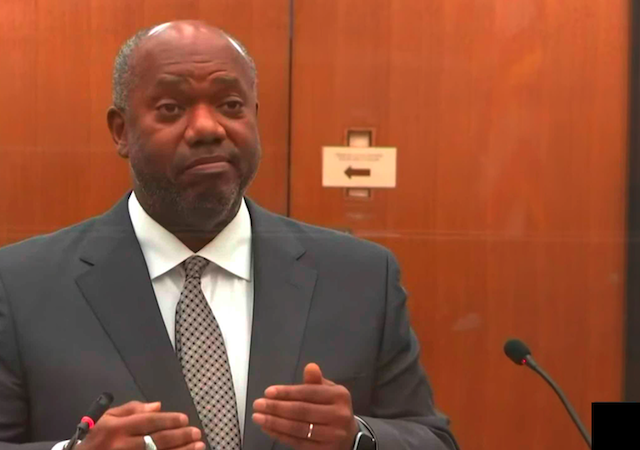
Welcome to our ongoing coverage of the Minnesota murder trial of Derek Chauvin, over the in-custody death of George Floyd. I am Attorney Andrew Branca for Law of Self Defense, providing guest commentary and analysis of this trial for Legal Insurrection.
As a reminder, I am “LIVE Parlering” the trial in real-time over at Parler.com, which you can find using my Parler handle: @LawofSelfDefense.
This morning the court first had a debate on whether the state should be permitted to introduce expert witness testimony on George Floyd’s state of mind, which the defense argued would open the door to admission of Floyd’s year-prior arrest-related drug ingestion event. Judge Cahill indicated he’d have a decision on all that on Friday (tomorrow). More on that in a moment.
Following that debate the court conducted voir dire on four jurors, all of whom happened to be female.
The first, #86, was struck quickly as she told Judge Cahill she had formed a fixed and biased view of the defendant.
The second, #87, was struck by the state, leaving the state with four strikes—more on her in a moment.
The third, #88, was dismissed by the court because she was personally familiar with one of the key witnesses in the case.
Finally, #89 was seated on the jury, and is now the tenth juror seated in this trial—more on her in a moment.
Debate on State Expert Witness & Floyd’s Prior Drug Ingestion
For roughly the first half hour of today’s proceedings the state argued for the admission of testimony for one Dr. Vincent, who is prepared to offer expert testimony as to George Floyd’s state of mind during his 2020 encounter with police.
In effect, the state is arguing that they expect the defense to claim that Floyd was resisting arrest and that his conduct was driven by his illicit drug intoxication.
The state instead would like to argue that Floyd may have been non-compliant, but that this must be distinguished from resisting because the non-compliance was not voluntary and intentional.
Rather, Floyd’s non-compliance was beyond his control, and driven by anxiety and PTSD of just having had one of the officers point a gun at him, as well as by Floyd’s claustrophobic fear of being placed in the squad car. Dr. Vincent will purportedly testify that Floyd’s conduct was reasonable for anyone in those circumstances.
The state will also use this evidence to argue that Chauvin should have realized that Floyd’s non-compliance was not intentional and used de-escalation techniques as per Minneapolis Police Department policies.
This, the state will argue, would make Chauvin’s chosen use of force upon Floyd counter to MPD policy, objectively unreasonable, and thus the basis for criminal liability.
The defense is arguing that if the court allows this testimony by Dr. Vincent then it opens the door to admission into evidence of the entirety of Floyd’s year-prior arrest-related drug ingestion event, to rebut the state’s expert witness testimony.
In that case there was no gun pointed in Floyd’s face, he was still non-compliant with arrest, he had also ingested illicit drugs, and he made no claims of claustrophobia when placed in a squad car.
Judge Cahill seems inclined to either exclude both the state and defense offers of evidence on this issue, on the one hand, or to allow both, but not one or the other. In addition, Cahill had already been disposed to allow some portion of the year-earlier drug ingestion event into evidence, but to rebut the state’s expert witness testimony would allow all the evidence of that event. He ultimately announced that he’d have a decision on all this on Friday (tomorrow).
Here’s the video of that debate:
Juror #87, Stay-at-Home Mother of Five: Struck by the State
Juror #87, a female, and stay-at-home mother of five, who thought media reports of racism were likely exaggerated, on the grounds that the media generally exaggerates everything they cover, believed the protests following Floyd’s death were overwhelmingly negative, had a very unfavorable view of Black Lives Matter as an organization although she did affirm strongly that black lives matter, and strongly agreed that the police in her community made her feel safe, was perfectly acceptable to the defense, but was struck by the state using a peremptory challenge. This leaves the state with four remaining peremptory challenges, after which they can have jurors excused only if they can show the court cause.
Here’s the video of the voir dire of prospective juror #87, now dismissed:
Juror #89, Registered Nurse, Cardiac and Respiratory: Seated on the Jury
Juror #89, a long-time registered nurse, currently works providing ventilation support to COVID patients. She had previously worked as a cardiac nurse. This experience created concern for both the defense and state, and even Judge Cahill, that she might offer her own “expert testimony” to the other jurors, but she committed to restraining herself from doing so.
In contrast to #87, #89 did not feel that the media exaggerated reports of racism, and indeed thought the truth was probably worse than what was reported. She also believed the criminal justice system did not treat black and white defendants equally. At the same time, she agreed that just because a white police officer had an interaction with a black suspect did not make that interaction racist in nature.
Here is the video of the voir dire of juror #89, now seated as the 10th juror on this trial:
OK, folks, that’s all I have for all of you until our end-of-day post today, after the court recesses for the day.
Until next time, stay safe!
–Andrew
Attorney Andrew F. Branca
Law of Self Defense LLC
Attorney Andrew F. Branca’s legal practice has specialized exclusively in use-of-force law for thirty years. Andrew provides use-of-force legal consultancy services to attorneys across the country, as well as near-daily use-of-force law insight, expertise, and education to lawyers and non-lawyers alike in the form of blog posts, video, and podcasts, through the Law of Self Defense Membership service. If this kind of content is of interest to you, try out our two-week Membership trial for a mere 99 cents, with a 200% no-question- asked money-back guarantee, here: Law of Self Defense Membership Trial.
[Featured image is a screen capture from video of today’s court proceedings in MN v. Chauvin.]
 DONATE
DONATE
Donations tax deductible
to the full extent allowed by law.

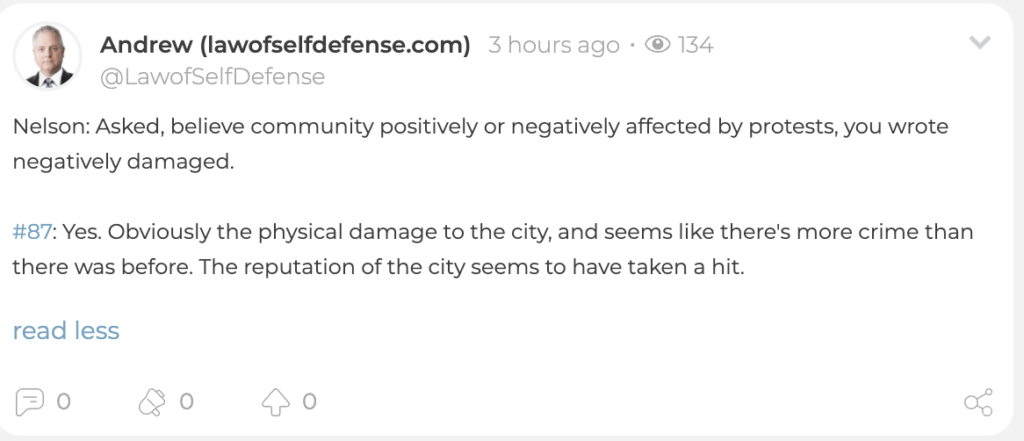

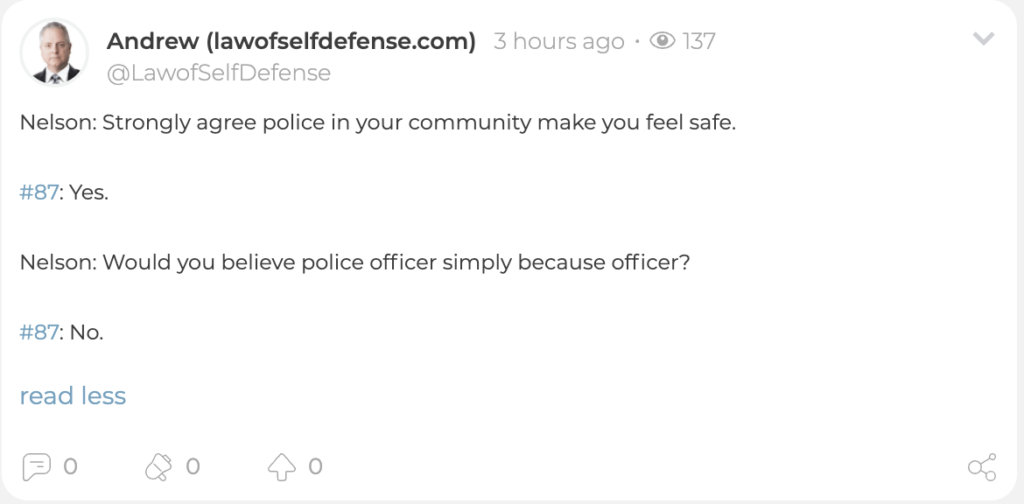

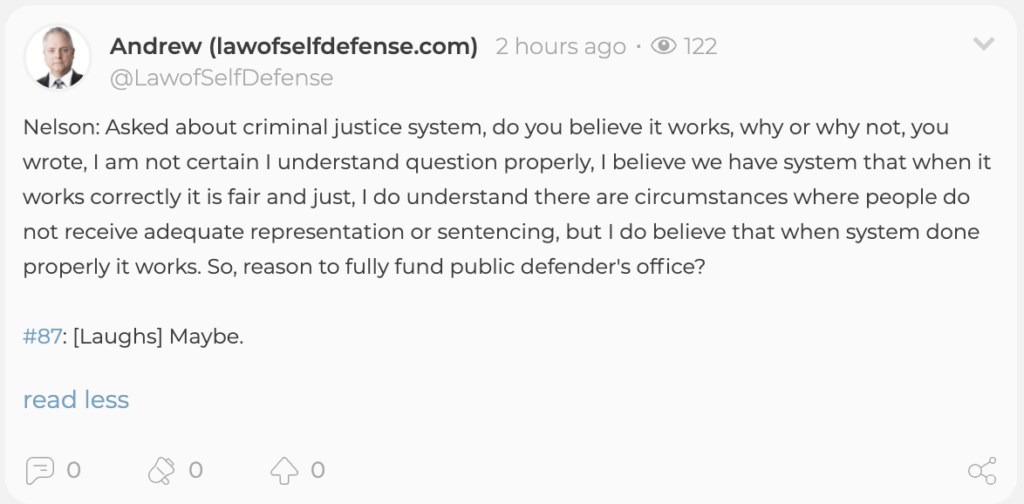

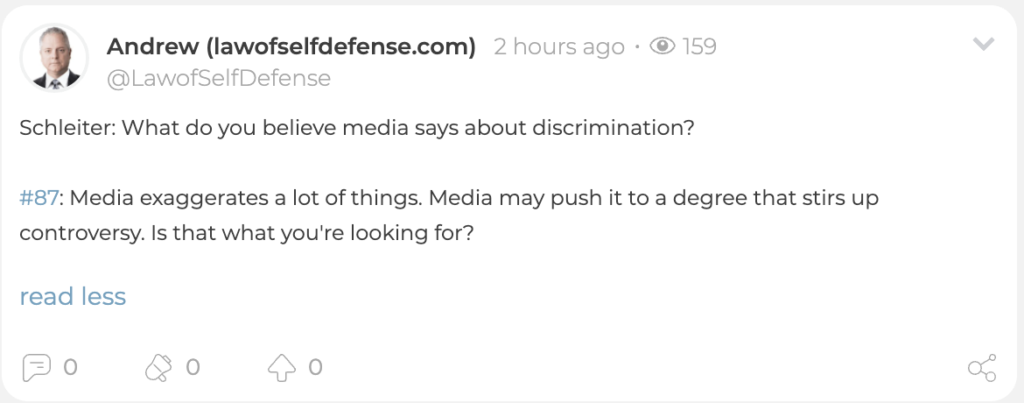

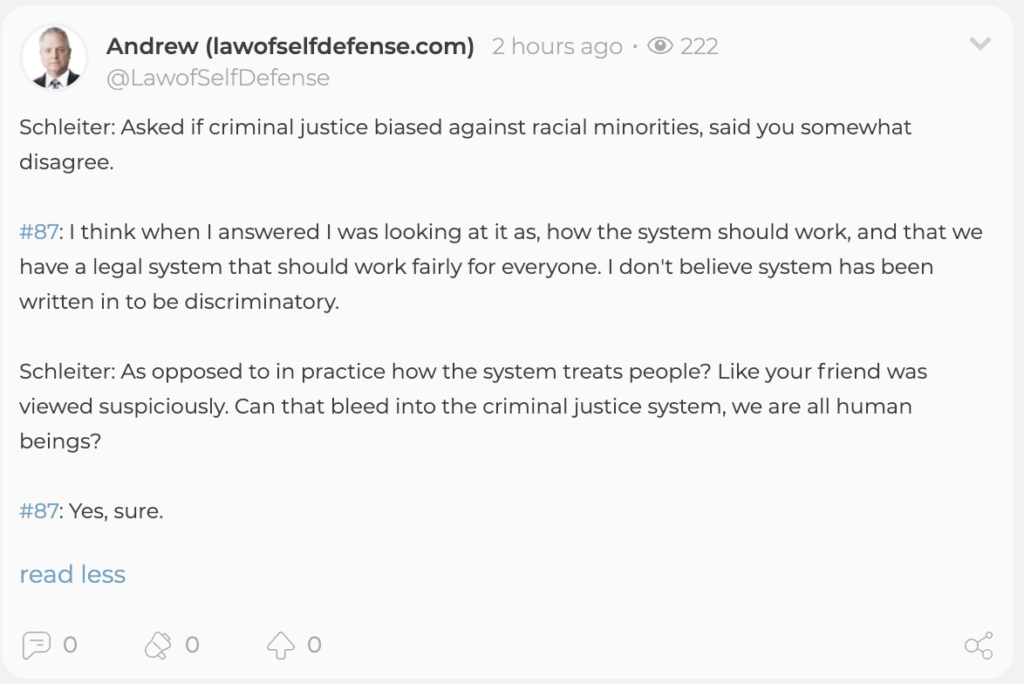
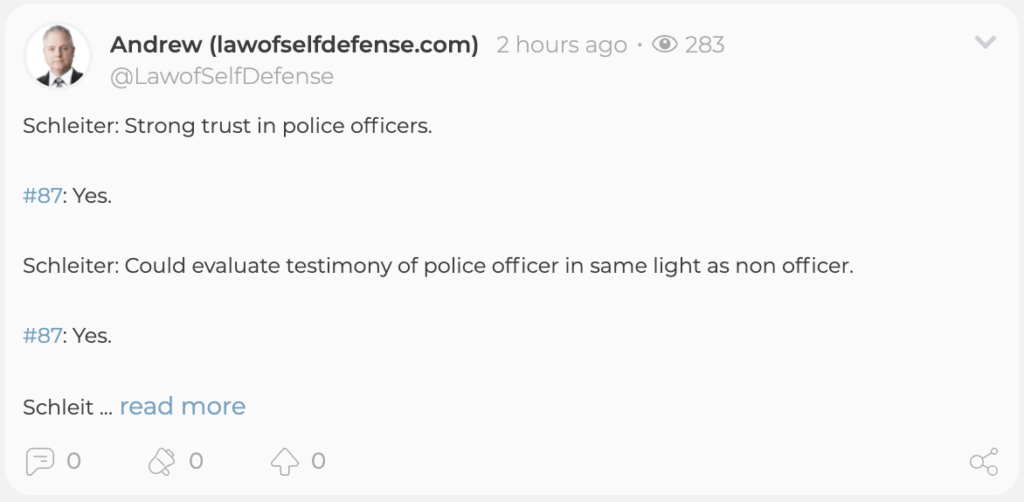



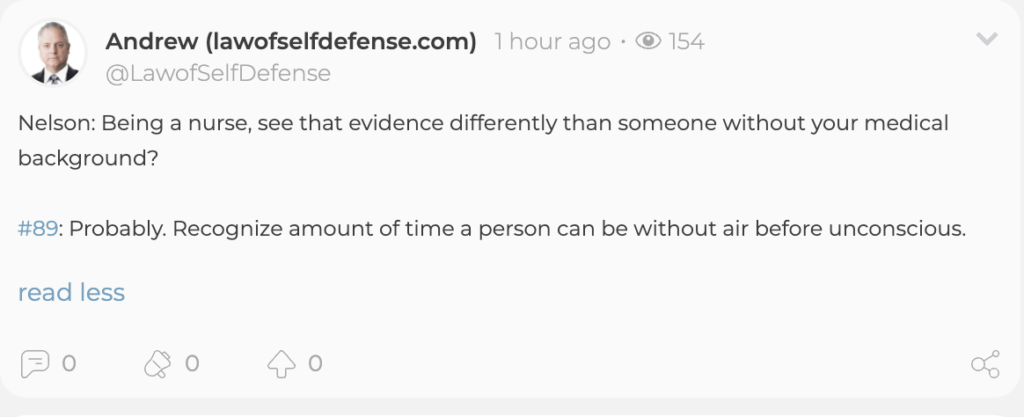
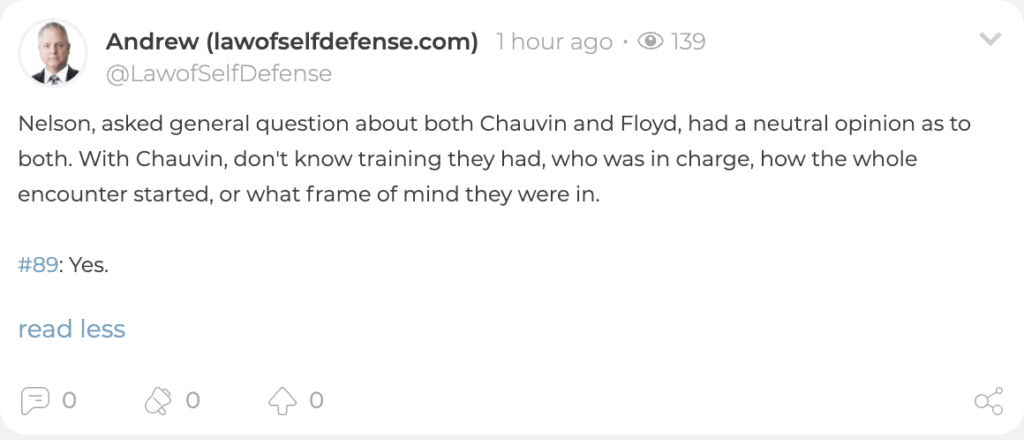




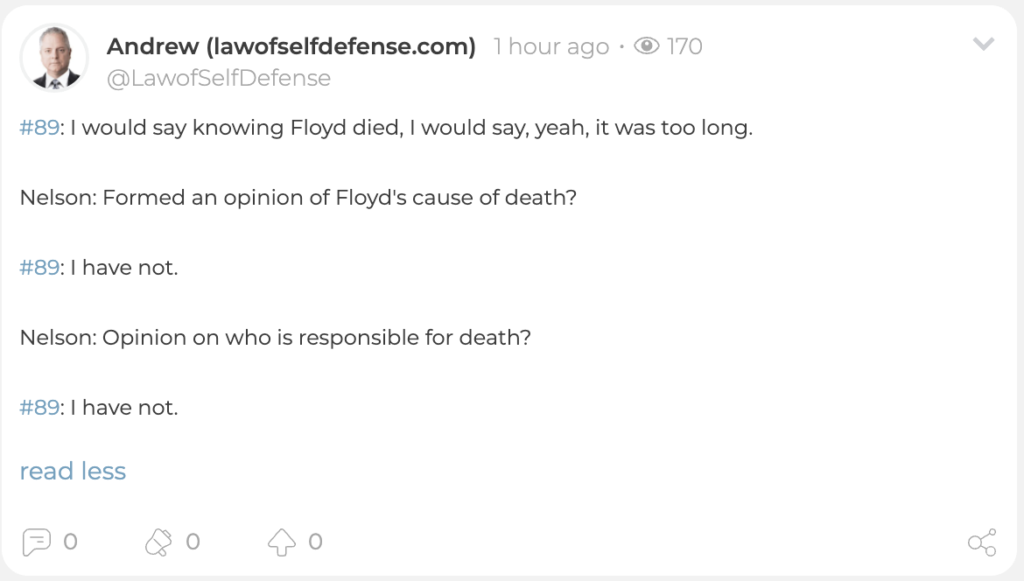

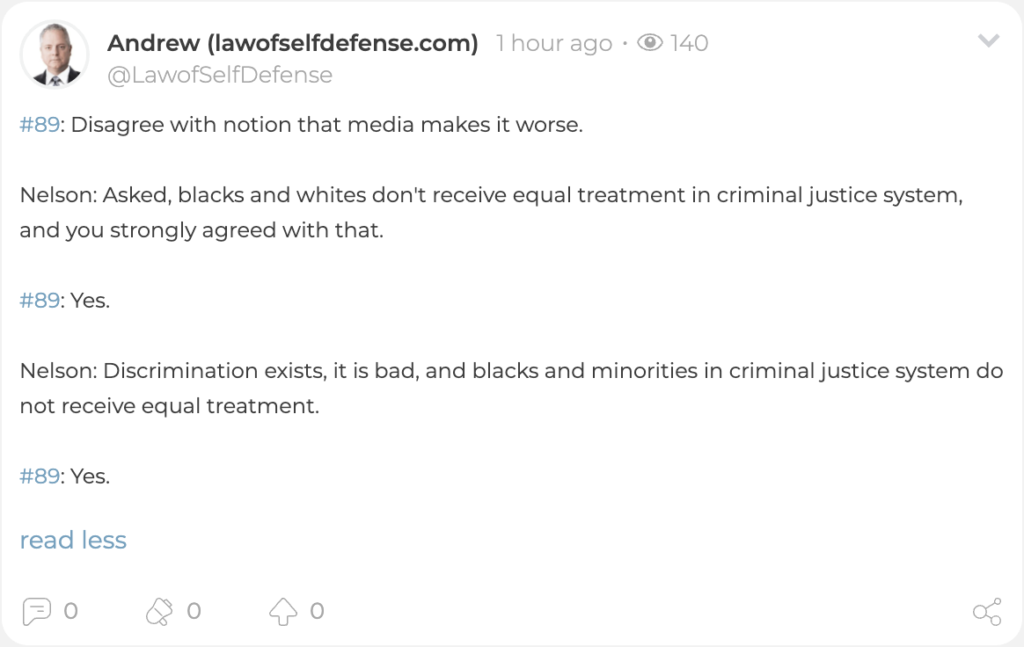

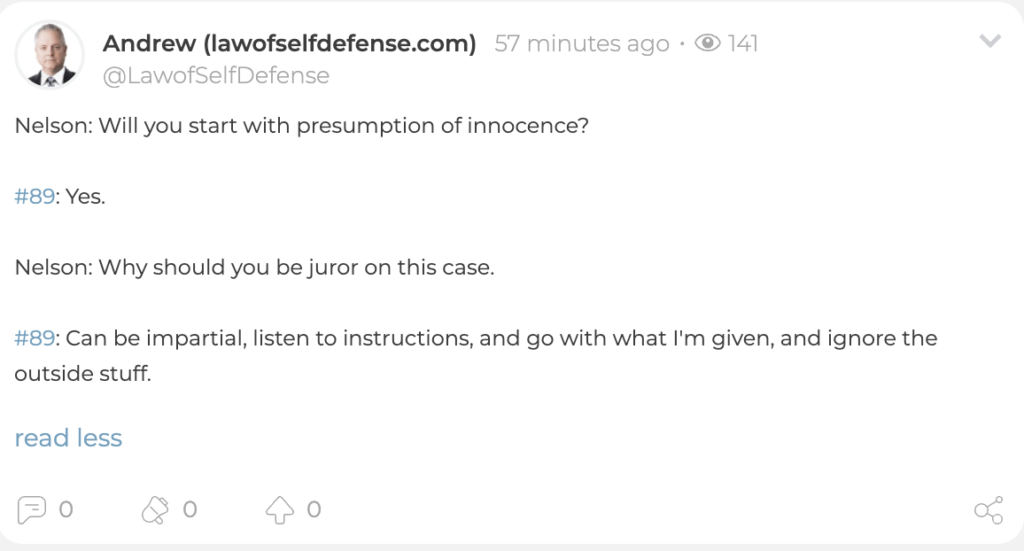
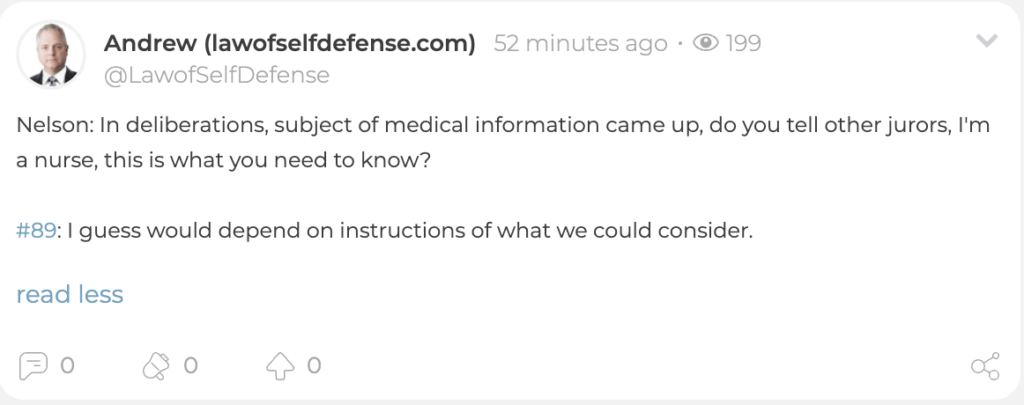
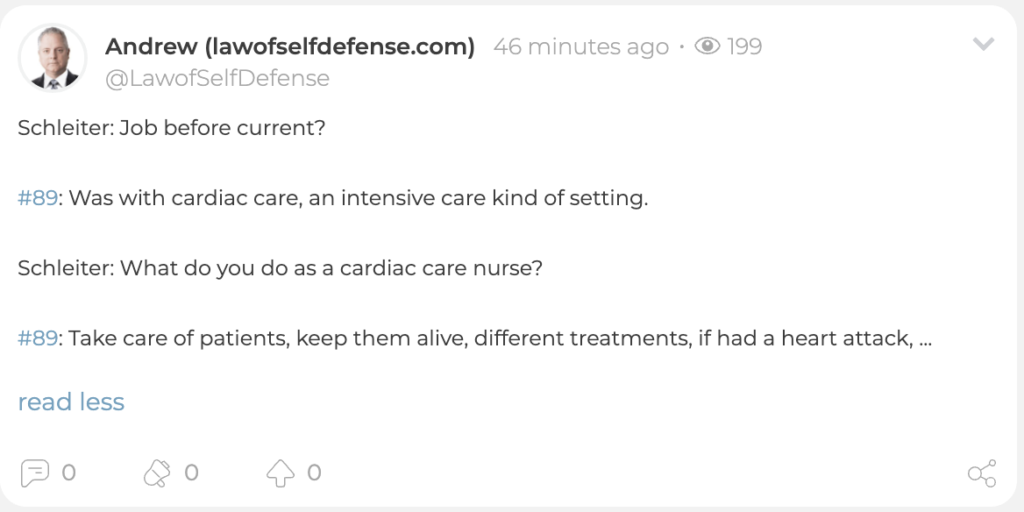
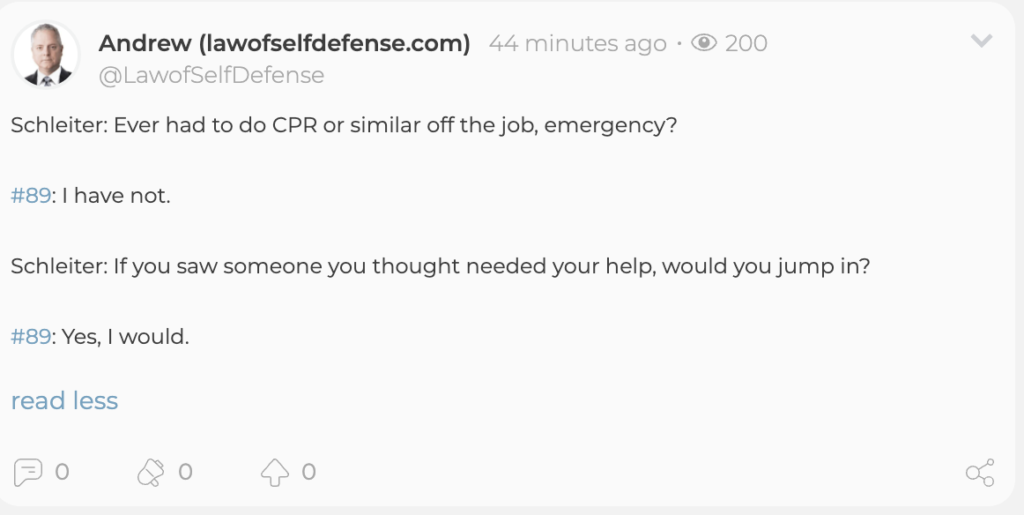









Comments
I don’t understand why it matters whether the resistance was voluntary or involuntary. The point is that he was resisting, and thus had to be subdued. He’s not being blamed for resisting, or for anything else; he’s dead and not on trial. His culpability shouldn’t be an issue.
How should he have realized it? He arrived on the scene and found a resisting suspect; how should he have known why? Should he have stopped and asked the suspect to explain himself? Read his mind? Guessed? And supposing he had somehow known, how would that change the fact that before he did anything else he had to bring the suspect under control?
“How should he have realized it? He arrived on the scene and found a resisting suspect; how should he have known why? Should he have stopped and asked the suspect to explain himself? Read his mind? Guessed? And supposing he had somehow known, how would that change the fact that before he did anything else he had to bring the suspect under control?”
Not that I think there is any validity to this argument by the prosecution, I expect they will point to the fact that Floyd repeatedly told the police he was claustrophobic and also told the police that he was freaked out that they had pointed a gun at him.
I guess the argument is that Floyd wasn’t simply resisting, but rather he was undergoing something akin to a panic attack, and that should have been dealt with by different means.
It seems kind of hard to dispute that the “panic” wasn’t more likely caused by a massive ingestion of Meth and Fentanyl though! ?
OK, but different how? At the end of the day, panic attack or no, the suspect has to be restrained.
I don’t see why the cause should have made a difference.
I think the prosecution is arguing that at the end of the day police did not have to restrain Floyd, that they should have talked him down instead because talking someone down always works in an artificial hypothetical scenario.
OD induced panic is caused by unlawful conduct which further validates the resisting arrest argument. Actual panic would be a mental disorder and possibly fall under different departmental regulations IF identifiable as such.
I read someplace,, George Floyd’s condition, what you called a panic attack, was actually excited delirium.. Perhaps someone in Law Enforcement has heard of this condition. One sign is profuse sweating..
Too complex a set of issues for any cop on the street to deal with. Sweating can also be from heart issues. Floyd was a walking dead man. As Milhouse notes, it doesn’t make a difference… to ensure safety for all concerned, Floyd had to be subdued. One has hard or soft restraints as options… in this case … “hard” was needed. From my view… the cop neither intentionally or unintentionally killed Floyd. So…hum… inject every resisting person with Narcan and Dextrose just to be sure? Or risk Librium to tamp DTs?
As soon as George Floyd chugged his stash, he was a dead man walking. It’s the sad tragedy of being a police officer. You can’t save them all.
I don’t know whether it was excited delirium, but that was certainly the cops’ assumption. They explicitly said so in their discussion of whether to move him to a different position. As I understand it the knee hold is specifically prescribed for excited delirium, and that is why Chauvin used it, and why he was reluctant to change to a different hold when it was just a matter of minutes for the medics to get there and then it would be their problem.
What other “de-escalation techniques” was Chauvin supposed to try, according to the state? Other cops had already offered to sit in the back of the cop car with Floyd, they’d offered to open the window of the car and turn on the A.C., they’d let Floyd get out of the car after he started kicking and fighting, and they’d put him on the ground after he asked repeatedly to be placed on the ground. What more were they supposed to do to accommodate him? The cops had been trained that they needed to restrain suspected drug addicts showing signs of excited delirium, for their own protection as well as to keep the suspected addict from self-harming. That’s what they were doing. Chauvin had a knee on Floyd’s neck, but from the video (and the findings by the ME) it doesn’t appear that he was putting any weight on Floyd’s neck. He was just making sure Floyd stayed put, which is what he’d been trained to do.
On, or at? The positioning would be the same, but the weightforce would differ.
I am a few days late to this discussion, but it seems to me if there was enough weight put on a guy’s neck for eight minutes to kill him then there would be bruising. There might also be bruising if there was not enough weight put on to kill him, but the absence of bruising would seem to rule out the knee as cause of death.
Has anyone heard if the ME’s report showed there to be bruising on the neck?
Two points, Whether or not the judge allows the prior incident into evidence, the defense needs to have this in the record otherwise lose the issue for appeal. Second, assuming his resistance was due to his ingestion of the drugs, then the resistance was voluntary not involuntary. The prior incident becomes relevant because Floyd probably believed “i did this last year and survived, i can do it again and survive”.
Claustrophobic? Sure .. ONLY in police vehicles … but not in his own vehicle. And everyone KNOWS, LEO’s have PhD’s in psychology to recognize the difference between claustrophobia (or other mental issues) and a suspect simply resisting arrest.
Juror 89 – seems to be afraid of being on the jury. Maybe easily swayed to vote guilty for her personal safety
If Floyd’s prior drug swallowing were being used to prosecute Floyd, I could see excluding it as prejudicial. BUT in this case, it’s a defense issue. Spoils the state argument that Floyd was an angel. The defense as a matter of course is usually allowed the widest latitude in what prior events to admit into evidence. And in this case- it’s directly related, there are no questions, if, ands, or buts that it’s relevant to what happened. Too bad for the prosecution, but they really should have a pretty good case that can’t be disproved, or placed into jeopardy, by prior behavior of someone not being prosecuted.
I agree, but it didn’t work in the Zimmerman trial.
The defense was not allowed to bring up any of Trayvon’s sordid past involving burglary and street fighting.
In the subhead, I think you meant “joust” as in knights of old, not “joist” as in house construction . . . but then autocorrect dunno much . . .
That had me really confused too! I wondered if it was a unique legal term but it’s not showing in the dictionary.
I find it odd that the RN was seated and the teacher was excused for hardship. I know she probably didn’t ask but still the optics are pretty funny…to me at least.